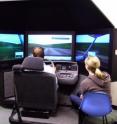Drivers distracted more by cell phones than by passengers
Drivers are far more distracted by talking on a cellular phone than by conversing with a passenger in an automobile, according to a new study by University of Utah psychologists Frank Drews, David Strayer and Monisha Pasupathi. The study, which used a sophisticated driving simulator, found that when drivers talk on a cell phone, they drift out of their lanes and missed exits more frequently than drivers conversing with a passenger.
The findings are being released Monday, Dec. 1 by the American Psychological Association and published in the Dec. 15, 2008, issue of the Journal of Experimental Psychology: Applied.
"The passenger adds a second set of eyes, and helps the driver navigate and reminds them where to go," says Strayer, a professor of psychology at the University of Utah and a co-author of the study.
Previous studies by Strayer and Drews have found that hands-free cell phones are just as distracting as handheld models because the conversation is the biggest distraction. They also have shown that when young adults talk on cell phones while driving, their reaction times become as slow as reaction times for senior citizens, and that drivers talking on cell phones are as impaired as drivers with the 0.08 percent blood alcohol level that defines drunken driving in most states.
Strayer says he often is asked about the distraction caused by conversations with passengers versus people on the other end of a cell phone, "because in both cases you have a conversation."
But "when you take a look at the data, it turns out that a driver conversing with a passenger is not as impaired a driver talking on a cell phone," he says. "You see bigger lane deviations for someone talking on a cell phone compared with a driver talking to a passenger. You also find when there is a passenger in the car, almost everyone takes the exit. But half the people talking on the cell phone fail to take the exit."
Drews concludes: "Friends don't talk to their driving friends on cell phones."
Strayer adds: "The difference between a cell phone conversation and passenger conversation is due to the fact that the passenger is in the vehicle and knows what the traffic conditions are like, and they help the driver by reminding them of where to take an exit and pointing out hazards."
Source: University of Utah
Articles on the same topic
- Hands-free cell phone conversations add 5 m to drivers' braking distancesWed, 3 Dec 2008, 15:35:11 UTC
- Drivers make more errors when talking on cell phone than to a passengerMon, 1 Dec 2008, 5:30:25 UTC
Other sources
- Hands-free cell phone conversations add 5 m to drivers' braking distancesfrom PhysorgWed, 3 Dec 2008, 18:00:27 UTC
- Hands Free Mobile Phone Conversations Add Five Meters To Drivers' Braking Distancesfrom Science DailyWed, 3 Dec 2008, 1:28:18 UTC
- Cellphones distract drivers more than passengersfrom CBC: Technology & ScienceMon, 1 Dec 2008, 15:00:35 UTC
- Cellphones distract drivers more than passengersfrom CBC: HealthMon, 1 Dec 2008, 14:37:03 UTC
- Drivers Distracted More By Cell Phones Than By Passengersfrom Science DailyMon, 1 Dec 2008, 14:36:59 UTC
- Drivers make more errors when talking on cell phone than to a passengerfrom PhysorgMon, 1 Dec 2008, 12:14:23 UTC
- Phones and hangovers distract drivers, studies showfrom The Guardian - ScienceMon, 1 Dec 2008, 0:42:26 UTC
